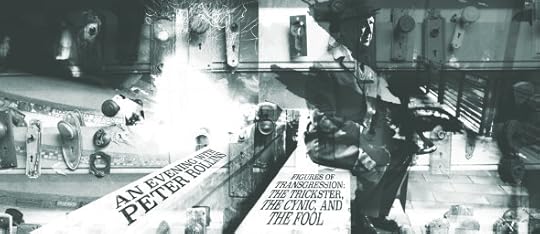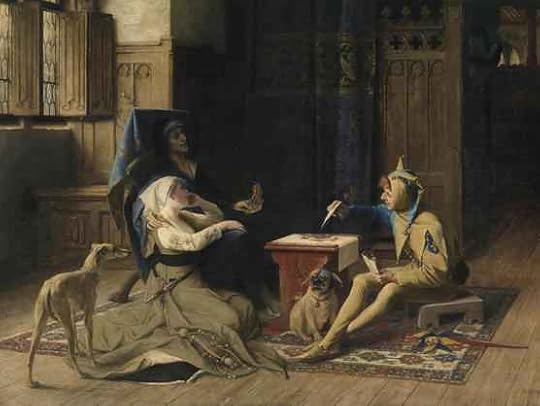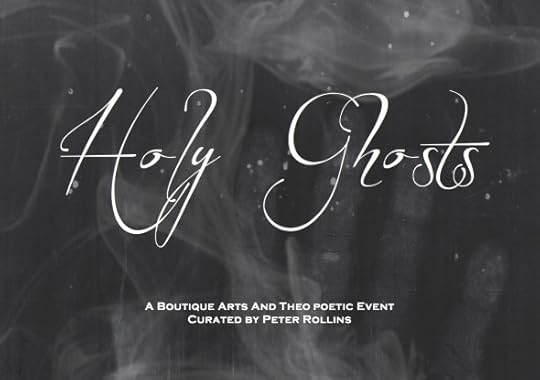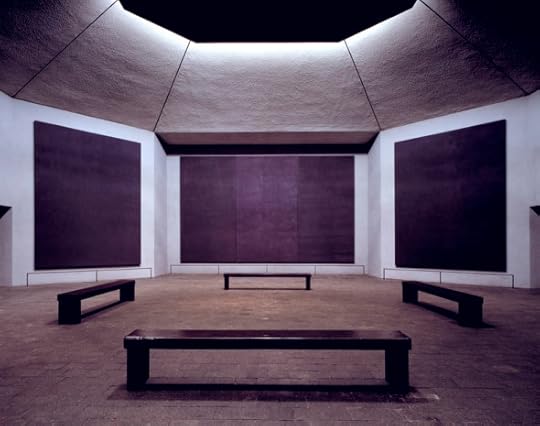Peter Rollins's Blog, page 28
June 2, 2014
Mars Hill, Grand Rapids, MI
I’ll be speaking at both their 9am and 11am services. To find out where they meet, click here
May 14, 2014
Figures of Transgression, Seattle, WZ

Figures of Transgression: The Trickster, the Cynic, and the Fool
A Town Hall Event with Peter Rollins.
At worst, religion in the West stands as a reactionary force dedicated to maintaining the status quo, while, at best, it tends to lag behind cultural and political innovations, instituting changes only after the moral victories have been won. Its seemingly high ideals of balance, harmony, and submission to divine Will too often cash out in an acceptance of the dominant ideology and political apathy. In contrast Peter will outline a type of religionless faith that places value on wrestling, antagonism, and radical self-interrogation; a faith, he argues, that blurs the lines between atheism and theism, and which offers genuine hope for a better future. Join Peter and The Seattle School community for an evening of conversation, wrestling, and hope.
The dialogue will take place from 7:00 to 8:30pm and will be followed by a meet and greet from 8:30 to 9pm.
May 7, 2014
The King and His Jester: Religion and its Acceptable Transgressions
Religion, in its various forms, offers up a constellation of acceptable beliefs and practices that tell us how to think and behave. A denomination, for instance, will offer us a set of dogmas, doctrines and rituals that, to a greater or lesser extent, let us know how to interact with the world. Political, moral and social positions can all be unfolded in relation to these.
In light of this it might seem that the relation between law and transgression is relatively simple. You obey the rules and you remain an acceptable member of the church. You disobey the rules and you get into trouble, perhaps even finding yourself disciplined or excommunicated.
Yet the reality is more complicated and interesting, for religion doesn’t simply offer a set of positions to conform to, it also offers the acceptable ways in which one can transgress these positions: it tells us both how to conform and how to not conform in a conformist way.
In a previous post I explored this logic in relation to a family where sleeping with a partner outside of marriage is viewed as morally unacceptable. For many of these families however there is an acceptable way in which the transgression against this law can be managed. As long as the child sleeps a in separate room from their partner when visiting their parent’s house, and doesn’t talk about how they live with their partner, everything carries on as usual. This logic can be outlined in the following way,
Law: Don’t sleep together
Acceptable Transgression: You can as long as we all pretend you aren’t when we’re together
In more explicitly religious terms we can see this relationship between the law and acceptable transgression in some churches relation to doubt. In a conservative church doubt may well be unacceptable (or doubt about certain central doctrines), yet it is acceptable to have them as long as you don’t share them in a formal church setting.
I remember meeting a woman who confided that she had doubts concerning the idea of a literal resurrection. She was an elder in her church and a long time worship leader, but she told me that, if she spoke publicly about her doubts she’d likely be asked to step down from her position. At this point I asked whether she thought the other elders might have similar questions. Her response was telling, “well, I suppose they must, I mean many of them have been doing this for years, I really can’t imagine that they don’t.” In other words, if she was correct, the real transgression in her community lay not in having doubts about the resurrection but in speaking them. We can outline this in the following way,
Law: Don’t doubt the Resurrection
Acceptable Transgression: You can, just don’t talk about it in church
Unacceptable Transgression: Talking openly about it in church
This idea of Law and its acceptable transgression is a central insight of Zizek’s Lacanian theory, and is captured well in the analogy of a king and his Jester. The jester, or fool, was a court entertainer who, in addition to performing tricks, was able to joke with and even mock royalty. Indeed Queen Elizabeth once chided her jester for not being cutting enough in his humour. A jester, however, walked a tight rope, for if they were too mocking they left themselves open to punishment or even execution. Thus they had to transgress the court in an acceptable way to the court. In short, their transgression had to be endorsed by the very system it seemed to act against.
This can help us see how the person who transgresses in a way that is acceptable to the system they are part of is not a thorn in the side of that system but is actually an important part of it. Indeed such fools are needed by the system itself in order to allow its people a certain edgy pleasure that helps facilitate the smooth running of the machine.
“Backsliding” provides an interesting case in point. If someone considers herself a backslider she is defining themselves both within and against the system that she is a part of. As a backslider she is accepting the religious position that she is transgressing against. Because she defines herself in relation to it she continues to support its truth even though she acts against it.
Backsliders thus have a position within the system they fall short of, even though this position is generally a lesser one. More than this, backsliders will often return to the fold in time; either giving up their old ways, or learning how to engage them in ever more acceptable forms. Indeed a “backslider” is often simply one who hasn’t yet realised that what they are doing is actually possible within the very heart of the system itself, as long as they manage it well and don’t talk about it.
In contrast to the jester, the trickster is someone who transgresses against a system they are part of in a way that genuinely jars the system itself. The trickster is a revolutionary figure who is able to expose the reactionary moral, political and cultural thinking that closes an ideology in upon itself and crack it open to real self-interrogation and transfromation. Tricksters will look very different to each other depending on their context, for they do not share similar beliefs so much as a similar structural position within a particular system of belief. They act then as a type of new wine that ruptures old wineskins.
Take the example of Dan Haseltine, the lead singer from Jars of Clay. Within his community his recent public questioning of homosexuality as immoral was truly transgressive to that community (as evidenced by the huge pushback he received). Within a less fundamentalist environment such a questioning would be laughable, but within his body of listeners it acted as a genuine rupture that brought to light repressed doubts within that community.
When standing against ideological systems then we must ask the difficult question concerning whether we are real tricksters or mere fools.
April 25, 2014
Continual Subversion: Pyrotheology, Dialectics and the Art of Disruption
The term “Transformance Art” was coined a number of years ago to describe the praxis of Pyrotheology. Transformance Art is basically a practice that employs various art forms in an attempt to disrupt, disturb, surprise and confront a given individual/community with themselves. This disruption involves bringing to light the things that the individual/community have repressed, things that are likely causing suffering and/or violence. This is why terms like “doubt,” “brokenness,” “lack,” and “self-examination,” are so central to the lexicon of Pyrotheology.
However, when teaching on the subject, I’m often asked what would happen should this transgressive discourse ever achieve popularity. Basically the question is, “if Pyrotheology were to become a new orthodoxy, would that not undermine it’s own ability to unnerve and subvert us”?
This question revolves around the insight that any system of belief can become a type of enclosure to prevent us from being shocked by our own being and disturbed by our own acts. Indeed, as New Atheism makes clear, even a discourse that champions certain forms of non-belief can fall into this trap.
What is missed here is the way that Transformance Art is not designed to preach some system of belief (or non-belief), but rather to encourage a form of dialectic movement in the lives of those who participate.
Take the true example of a young man in analysis who described his attachment to a particular woman in terms of a drug addiction. During a session he spoke of how he sought the high of the connection with her even though these were inevitably followed by long, dark lows. As the session came to an end the therapist simply asked if the young man was in fact an addict who was seeking after the lows rather than the highs.
This rhetorical question had the effect of opening up a new line of thought in the analysand, one that enabled him to explore the idea that he might get something out of his depression, and might even be seeking it out in some unconscious way.
The question asked by the analyst in this session is an example of how a type of dialectic movement might be encouraged, one that can effectively shake an individual out of a certain groove of thought. In a subtle way the analyst was able to present an opposite idea that seemed to uncover a more complex relation to pleasure and pain in the analysand, one that he was previously unaware of. In this brief moment the analysand was surprised by himself and disturbed in a fruitful way.
This is a dialectic move precisely because the negation is already a negation of negation. For when the question, “Are you actually seeking the low” is posed, there is an implication that the individual might be seeking the low because that is where the real high is. In dialectic terms it works like this,
Affirmation – I’m seeking the high
Negation – I’m seeking the low
Negation of negation – I’m seeking the low because I get some kind of high from it
From this insight the analysand might be more able to self-interrogate why he holds onto painful situations.
This example can help us understand one of the fundamental opening moves of Transformance Art. For those who put these events on are committed to a type of dialectic dynamic which attempts to uncover the hidden shadows of the conscious affirmations in a given group. All of which is in the service of surprising the community with its own repressed content (with the hope that this disruption leads to a more healthy, active and joyful community).
This means that Transformance Art aims to be an inherently subversive discourse, one that continually attempts to negate the affirmation of a particular group, regardless of what that affirmation is.
April 16, 2014
Explore Your Holy Ghosts
I’m currently getting ready to leave for Belfast to put the finishing touches on my Holy Ghosts event before next weeks kick off. Over four days we have the following people joining us,
Screenwriter and director Phil Harrison (showing his award winning short Even Gods and his feature film The Good Man ahead of it’s cinematic release in May), academics Katharine Moody, John Caputo (via Skype) and Gladys Ganiel, poet Padraig O Tuama, artists Jonny McEwen and Micah Purnell, musicians Duke Special and John Hardt, politician John Kyle, and psychoanalyst Chris Fry.
In addition to all this we have whisky tasting, ghost tours, yoga, pub crawls, and fermenting classes on offer.
If you fancy coming, then grab one of the few remaining tickets ASAP
Trailer for The Good Man
Duke Special in action
Poet/musician Padraig O Tuama
April 4, 2014
Unconscious Gods, Seattle, WA
Unconscious Gods
Radical Theology, Psychoanalysis and the Critique of Religion
This graduate level course will explore some recent developments in contemporary critical theory that have particular pertinence for theological reflection and church practice. In particular the course will focus on the re-emergence of Radical Theology in Lacanian thinkers like Slavoj Žižek. By exploring post-Hegelian theory, Radical Theology and Lacanian psychoanalytic insights we will ask fundamental questions concerning the meaning of faith, the nature of future church and the proposed cure proclaimed by Christianity. Theorists covered during the course will include Tillich, Bonhoeffer, Zizek, and Caputo.
For more information contact the Seattle School of Theology and Psychology
In Exile conference, Houston, TX
TO RESERVE TICKETS, CLICK HERE
Despite the territorial divisions that separate theists from atheists, the sacred from secular, and the “faithful” from the “faithless,” many of us are painfully aware that we dwell on the borderlines. Occasionally, we pass from one side to the other and, more often than not, find ourselves in a liminal space that doesn’t belong to either side.
Whether we’re church leaders who find ourselves embarrassed by what we preach, humanists who sing hymns with the conviction of a saint, theists who find the idea of God absurd, or atheists who secretly pray – the walls that separate can often be more permeable than we might like to admit.
By employing the figures of the Trickster, the Cynic and the Fool, In Exile will explore three different ways that we can engage with our political, cultural and religious beliefs. By focusing on one these figures as a subversive model for how to embrace complexity, conflict, self-examination we’ll delve into a different model for collective experience that has far reaching implications for community formation.
Such communities have always existed and have gone by many different names, but they share a nomadic spirit that crosses the borders which divide one group from another, subverting and disrupting dominant political orders and opening up ways of living that don’t rely on signing up to a particular set of beliefs, dogmas or doctrines.
This event is for anyone who suspects that a borderline existence can mark communal life. It is for those who are open to self-interrogation and interested in radically different ways of sharing life together. Regardless of whether you work within the existing church, have long since left, or have never darkened its doors, this event will be relevant if you think there might be alternatives to “us versus them” spaces. This is for you if you suspect that a community of “neither/nor” is possible, one where difference no longer divides and where we learn to see the other as bearing a gift that might lead to our enrichment, or even transformation.
Friday evening opens with a service in the famous Rothko Chapel, then drinks. Saturday will take place in Sharespace.
Numbers are limited to 50 and lunch on Saturday is included.
Guests Include
We’ll be joined by author, speaker and church leader Danielle Shroyer. Danielle speaks on issues of theology, leadership and emerging communities of faith. She’s part of Journey Church in Dallas, where she served as pastor for 8 years. Danielle lives with her husband and two children in Dallas, Texas.
We’ll also hear from pastor turned provocatur Jerry Dewitt, who began his ministry at the tender age of 17. After 25 years of pastoring he embraced atheism and explores the fasinating journey in his book, Hope after Faith. Jerry lives in rural Louisiana.
Composer and guitarist George Heathco from the music ensemble Liminal Space will be performing at the Rothko Chapel event on Friday night. His music blends elements of contemporary concert music with rock, jazz, and other pop genres. He has written for numerious organisations and performed with Opera Vista, Divergence Vocal Theater, AURA Contemporary Ensemble, the Free Radicals, and the progressive/math metal band The Pant Factory.
April 1, 2014
Noah: Aronofsky on Obsession, Madness and Loss
With the financial success of films like God’s Not Dead and Son of Man, alongside the fact that other religious movies are being feverishly produced, 2014 has been christened “year of the bible” in Hollywood.
The first big budget film of the year that aims to cash in on this relatively untapped religious market is Darren Aronofsky’s Noah. At first blush it can be read as little more than a cynical Hollywood attempt to tap into a new monetary vein while still sucking from the one that’s fed them thus far. Offer up the relatively safe mix of eye-popping CGI, highly choreographed battles and simple emotional motivations to appeal to the average moviegoer, while wooing the faithful with a literalistic retelling of a biblical story.
Indeed it seem like the next logical step following the success that came from the producers of Superman, who created a series of sermons based on the film. Sermons written especially so that evangelical leaders could preach from the pulpit about how spiritual it was.
Yet, if this was the motivation of the producers, then it quickly becomes evident that Aronofsky outsmarted them by effectively building a Trojan horse out of the big budget blockbuster format so as to smuggle in a subversive and religiously disturbing content.
The exquisite scandal of Noah becomes clear when one views it in light of Aronofsky’s directorial debut, the darkly mesmerizing Pi. For while Noah is indeed Aronofsky’s first big budget film, it is his second cinematic exploration of the link between religious obsession and madness.
In Pi, the protagonist’s unrelenting drive for a formula that will unlock the secrets of the universe is revealed to be nothing less than a search for the name of God, a search that ends up in his mental and physical breakdown. In Noah, the protagonist undergoes a similar mental collapse when attempting to remain true to his divine call. While both films offer up different conclusions they each share the same fundamental theme.
It’s hard to miss the similarities that exist between Aronofsky’s Noah and Kierkegaard’s Fear and Trembling. For in both a deeply literal and faithful reading of a biblical event is employed to explore a monstrous horror embedded within it. For Kierkegaard; Abraham and Isaac. For Aronofsky; Noah and the flood.
It’s not surprising then that the religious market has broadly rejected the film even though it seems to support their cause. The problem for a religious believer is not that it fails to be literal enough, but that its very literalism uncovers a disturbing truth: that too close a relation to the Other results in a form of madness and death.
Just as Abraham and Isaac are a type of cipher for Kierkegaard, so to is Noah for Aronofsky. In Fear and Trembling we must take a step back from the text in order to see that this is in fact a deeply personal book in which he is wrestling with his love for Regina: the woman who owns his heart, and yet who remains, of necessity, forever distant. Regina stands in for the ultimate object of Kierkegaard’s desire, she is a sun that enslaves him in an impossible orbit, an orbit that prevents him from spinning into space or crashing into the flames (in a painfully poetic way this proximate distance continues to play out even in death, for Kierkegaard is buried just across the way from where Regina lies with her husband).
In the same way it is possible to perceive in Noah a very personal wrestling with what it means to obsessively love something, while maintaining a distance from it.
Psychoanalytically speaking, one might say that Noah is then dealing with the incestuous temptation to transcend the barrier separating us from the desire of The Thing (that Other which we want more than life itself). The choices we have in the face of this temptation being either to break through the prohibition and succumb to a form of death, or accept the barrier and live with an insatiable sense of loss.
Theologically speaking Noah (alongside Pi) can be read as cinematic expressions of Radical Theology, for Radical Theology can be said to precisely contend with the problematic of separation and loss from The Thing. Structurally speaking then, both Noah and Pi can be read as complex cinematic narratives exploring the consequences of getting too close to the object of our desire.
While Pi has a more radical, and pessimistic, conclusion, Noah offers us some hope. For as Noah is finally able to lay down his obsessive desire, and enter into the play of interpretation, he begins to heal. He is ultimately successful in separating himself from his incestuous desire to be a mouthpiece for his God and is reborn as a man marked by a loss, yet able to return once more to his family and to the everyday concerns of being in the world.
Peter Rollins's Blog
- Peter Rollins's profile
- 314 followers








